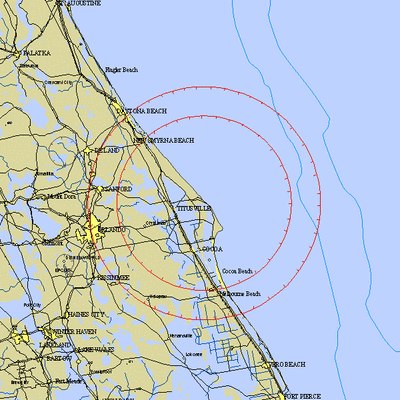 NOTAM Number: FDC 8/8731
NOTAM Number: FDC 8/8731
Issue Date: May 22, 2008 at 1826 UTC
Location: Cape Canaveral, Florida
Beginning Date and Time: May 31, 2008 at 1357 UTC
Ending Date and Time: May 31, 2008 at 2140 UTC
Reason for NOTAM: Temporary flight restrictions for Special
Security Reasons
Type: Security
Replaced NOTAM(s): N/A
Affected Area(s)
Area A
Airspace Definition:
Center: On the MELBOURNE VOR/DME (MLB) 004 degree radial at
30.6 nautical miles. (Latitude: 28º37'00"N, Longitude:
80º37'00"W)
Radius: 40 nautical miles
Altitude: From the surface up to but not including 18000 feet
MSL
Effective Date(s):
From May 31, 2008 at 1357 UTC (May 31, 2008 at 0957
EDT)
To May 31, 2008 at 2140 UTC (May 31, 2008 at 1740 EDT)
Area B
Airspace Definition:
Center: On the MELBOURNE VOR/DME (MLB) 004 degree radial at
30.6 nautical miles. (Latitude: 28º37'00"N, Longitude:
80º37'00"W)
Radius: 30 nautical miles
Altitude: From the surface up to but not including 18000 feet
MSL
Effective Date(s):
From May 31, 2008 at 1357 UTC (May 31, 2008 at 0957
EDT)
To May 31, 2008 at 2140 UTC (May 31, 2008 at 1740 EDT)

Operating Restrictions and Requirements
No pilots may operate an aircraft in the areas covered by this
NOTAM (except as described).
Except as specified below and/or unless authorized by ATC:
A. All aircraft operations within a 30 NMR area listed above are
prohibited except for:
Military aircraft and aircraft associated with Cape Canaveral
Operations, rescue/recovery, medical/lifeguard, emergency
evacuation, law enforcement, Department of State and fire fighting
operations which are permitted only with prior approval from the
appropriate ATC facility. Also, IFR regularly scheduled commercial
passenger and all-cargo carriers operating under one of the
following TSA-approved Standard Security Programs/Procedures:
Aircraft Operator Standard Security Program (AOSSP), Full All-Cargo
Standard Security Program (FACSSP), Model Security Program (MSP),
Twelve Five Standard Security Program (TFSSP) All Cargo, or
All-Cargo International Security Procedure (ACISP) and are arriving
into and/or departing from 14 CFR Part 139 Airports are authorized
transit with ATC approval.
B. Flight operations within the airspace between the 30 NMR and
40 NMR listed above are permitted only in accordance with the
following procedures:
All aircraft entering or exiting the 40 NM radius TFR must be on
an active IFR or VFR flight plan with a discrete code assigned by
an Air Traffic Control (ATC) facility. Aircraft must be squawking
the discrete code prior to departure and all times while in the
TFR.
All aircraft entering or exiting the 40 NM radius TFR must
remain in two-way radio communications with ATC.
All aircraft operating within the 30 to 40 NM radius TFR and
operating at altitudes of up to but not including FL180 are limited
to aircraft arriving or departing local airfields and ATC may
authorize transit operations. Aircraft may not loiter.
All VFR aircraft operations within the 30 to 40 NM radius TFR
are restricted to an indicated airspeed of 180 knots or less, if
capable. If unable the pilot must contact the appropriate ATC
facility and advise them of the aircraft's operational
limitations.
C. The following operations are not authorized within this TFR:
flight training, practice instrument approaches, aerobatic flight,
glider operations, parachute operations, ultralight, hang gliding,
balloon operations, agriculture/crop dusting, animal population
control flight operations, banner towing operations, model aircraft
operations, model rocketry, and unmanned aerial systems (UAS).
D. In the event that space shuttle launch is postponed, pilots
should check NOTAMS for next day launch and applicable flight
restrictions.
E. The 1st Range Operation Squadron, /45 Space Wing/ telephone
321-476-2192, is in charge of the operation.
Other Information:
ARTCC: ZMA - Miami Center
Authority: Title 14 CFR section 99.7
FMI: www.tfr.faa.gov,
Depicted TFR data may not be a complete listing. Pilots should not
use the information on this website for flight planning purposes.
For the latest information, call your local Flight Service Station
at 1-800-WX-BRIEF.
 Unfortunate... ANN/SportPlane Resource Guide Adds To Cautionary Advisories
Unfortunate... ANN/SportPlane Resource Guide Adds To Cautionary Advisories ANN FAQ: Turn On Post Notifications
ANN FAQ: Turn On Post Notifications ANN's Daily Aero-Term (04.29.24): Visual Approach Slope Indicator (VASI)
ANN's Daily Aero-Term (04.29.24): Visual Approach Slope Indicator (VASI) ANN's Daily Aero-Term (04.28.24): Airport Marking Aids
ANN's Daily Aero-Term (04.28.24): Airport Marking Aids ANN's Daily Aero-Linx (04.28.24)
ANN's Daily Aero-Linx (04.28.24)




